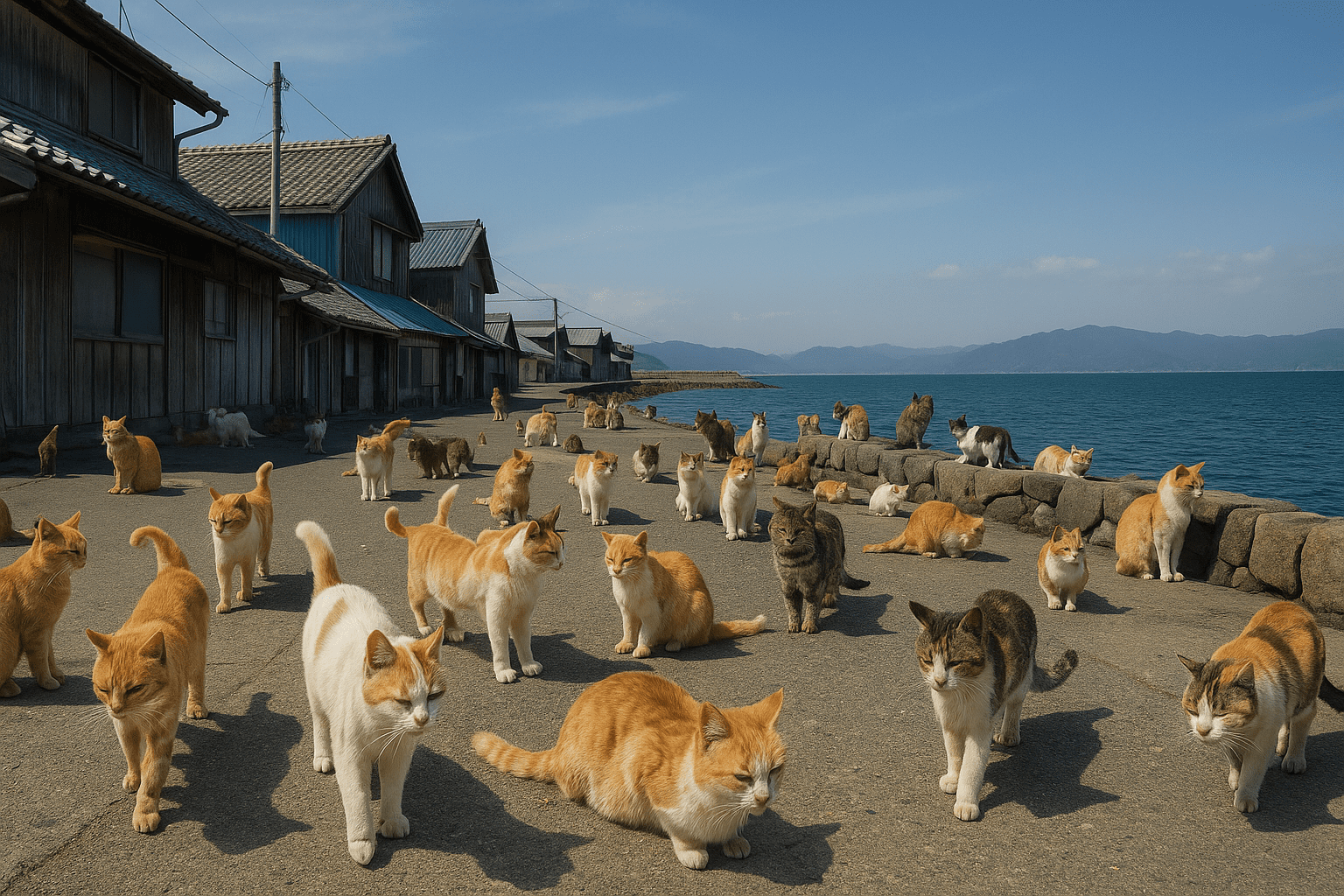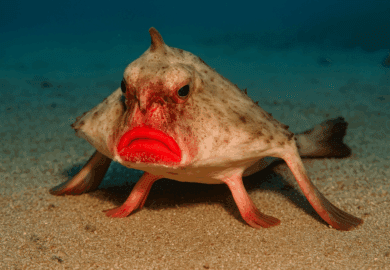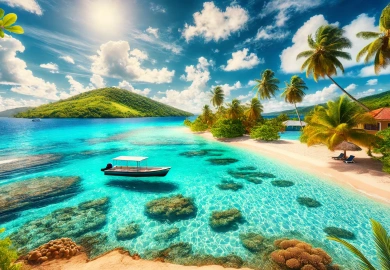
There’s a place in Japan where cats rule the streets, fishermen share their lunches with whiskered friends, and visitors are greeted with gentle meows instead of city noise. Welcome to Cat Island Japan — a peaceful corner of the world where felines outnumber humans and time seems to stand still.
Scattered along Japan’s coastline are a few small islands known as “neko no shima” (literally, “cat islands”). Among them, Aoshima in Ehime Prefecture and Tashirojima in Miyagi Prefecture are the most famous. These tranquil islands have become a dream destination for cat lovers, photographers, and travelers seeking a glimpse of Japan’s slower, more natural way of life.
The Story Behind Japan’s Famous Cat Islands
The origins of Japan’s Cat Islands go back centuries. Long before they became tourist attractions, these islands were humble fishing communities. Fishermen brought cats aboard their boats to control mice that threatened their catches and supplies. On land, cats protected silkworm farms — another vital source of income for islanders.
Over time, as the human populations aged and declined, the cats multiplied freely. Without natural predators and with residents often feeding them, they quickly became the islands’ most visible inhabitants.
In Japanese culture, cats are considered symbols of luck and prosperity. You’ve likely seen the famous maneki-neko — the beckoning cat figurine found in shops and homes across Japan. On the Cat Islands, this belief takes on a living form. Locals care for the cats with deep respect, seeing them as guardians of good fortune and calm spirits that bring balance to island life.
Today, visitors from around the world come not just to take photos, but to experience a place where nature, tradition, and animals coexist in quiet harmony.
Aoshima Island: The Quiet Kingdom of Cats
Hidden off the coast of Ehime Prefecture, Aoshima Island — often called “Cat Heaven on Earth” — is a tiny speck of land surrounded by calm blue seas. Despite its small size (only about 1.6 kilometers long), it’s home to dozens of cats for every one human resident.
Once a thriving fishing village with nearly 900 people, Aoshima now has fewer than 10 permanent residents, most of them elderly. The island has no shops, no restaurants, and no hotels — only narrow lanes, wooden houses, and cats napping on sun-drenched walls.
Arriving by ferry from Nagahama Port feels like stepping back in time. As soon as you set foot on the pier, you’re surrounded by curious cats — stretching, meowing, and sometimes escorting you down the path as if welcoming you to their kingdom.
Because Aoshima isn’t commercialized, visitors should come prepared with food, water, and essentials. The ferry runs just twice a day, so plan carefully. What Aoshima lacks in modern convenience, it makes up for in serenity. It’s a place where the sound of waves replaces car engines and cats are free to live as they please — watched over by the few islanders who still call this paradise home.
Tashirojima Island: Where Cats Are Sacred
Far to the north lies Tashirojima, a small island off the coast of Miyagi Prefecture, known for its strong bond between people and cats. Here, cats are more than just part of the scenery — they’re revered as sacred creatures.
Centuries ago, fishermen on Tashirojima believed that feeding and caring for cats would bring good luck and abundant catches. When a cat accidentally died, the islanders built a shrine in its honor, known today as Neko Jinja — the Cat Shrine. Locals still visit it to offer prayers and thanks, leaving small tokens and treats for their feline protectors.
Tashirojima also stands out for its quirky accommodations. Visitors can stay in cat-shaped lodges designed by fans of manga artist Shotaro Ishinomori, who loved the island and wanted to preserve its charm. These colorful lodges add a playful touch to an otherwise peaceful place, blending pop culture with traditional Japanese island life.
Walking through the two main villages, Nitoda and Oodomari, you’ll find cats lounging on fishing nets, strolling along seawalls, and curiously following guests down quiet paths. Each corner of the island feels like a living postcard — serene, photogenic, and full of personality.
How to Visit Japan’s Cat Islands: Aoshima and Tashirojima
If you’re planning a trip to Cat Island Japan, getting there is part of the adventure. Though remote, both Aoshima and Tashirojima are easy to visit with the right preparation.
Getting There: Ferries to Feline Paradise
If you’re dreaming of visiting Japan’s famous Cat Islands, planning your trip in advance will help you enjoy the experience to the fullest. Both Aoshima in Ehime Prefecture and Tashirojima in Miyagi Prefecture are easy to reach but offer only limited transport and facilities, so preparation is key.
Getting There: Ferries to Feline Paradise
To reach Aoshima Island, travelers must take a ferry from Nagahama Port in Ehime. It’s a short, scenic ride across calm waters — but with only two round trips per day, timing your journey is essential. Missing the last ferry means you’ll be waiting until the next morning, as there are no overnight accommodations on the island.
For Tashirojima Island, the journey begins at Ishinomaki Port in Miyagi Prefecture. Ferries depart several times daily, and the ride takes around 40 minutes. As you approach the island, keep your camera ready — it’s not uncommon to spot cats lounging by the docks, waiting to greet new arrivals.
What to Bring: Essentials for a Peaceful Adventure
Because these islands are small, rural, and wonderfully untouched by modern tourism, there are no restaurants, vending machines, or convenience stores. Visitors should come prepared with snacks, water, sunscreen, and any personal essentials for the day. A light backpack is perfect for carrying everything comfortably.
Walking is the best way to explore, so wear comfortable shoes and take your time wandering through narrow alleys, fishing harbors, and seaside paths. The slow rhythm of island life invites you to relax, observe, and connect with your surroundings — a rare treat for travelers seeking quiet escapes in Japan.
Island Etiquette: Respecting the Locals and Their Cats
The charm of Aoshima and Tashirojima lies in their simplicity — and in the mutual respect between people and animals. The cats on these islands are friendly, but they are not pets. Always let them approach you first, avoid sudden movements, and never pick them up or disturb their rest.
Feeding cats is allowed in moderation, but it’s best to avoid giving them human food. Many are already cared for by the residents, so small portions of cat-friendly treats are appreciated more than leftovers.
When exploring, remember that these are real communities, not tourist attractions. Many residents are elderly and value peace and quiet. Be mindful of private property, keep your voice low, and greet locals with a friendly nod or smile. Before leaving, make sure to take all your trash with you — preserving the clean, natural beauty of the island is part of being a responsible visitor.
A Journey Beyond Tourism
A trip to Japan’s Cat Islands isn’t just about seeing cats — it’s about experiencing life at a slower pace. Here, the modern world fades away, replaced by the sound of waves, the creak of fishing boats, and the gentle meows echoing through quiet streets.
Visiting Aoshima or Tashirojima is a reminder that true beauty lies in simplicity. Whether you’re a cat lover, a photographer, or a traveler seeking calm, these islands offer something precious: an unfiltered glimpse of harmony between humans, animals, and nature.
Why Cat Islands Capture the Heart
The magic of Cat Island Japan lies not just in its adorable feline residents but in the feeling these places evoke. On Aoshima and Tashirojima, modern distractions fade away. You’ll find yourself surrounded by silence, sea breeze, and the soft sound of paws padding along stone paths.
These islands offer something truly rare — a glimpse into a gentler way of living, where people and animals share space in quiet respect. They remind visitors to slow down, breathe, and find joy in the simple things: sunlight, salt air, and a cat curled up by your feet.
For travelers seeking authenticity and peace, Japan’s Cat Islands are more than a destination — they’re an experience of harmony. It’s a journey that leaves you with lasting memories, a calmer heart, and maybe a few new furry friends who’ll follow you to the ferry, meowing goodbye.
Final Thoughts
Visiting Aoshima or Tashirojima is like stepping into a living fairytale — one filled with whiskers, purrs, and breathtaking coastal beauty. These Japanese cat islands remind us that happiness doesn’t always come from noise or speed, but from simplicity, compassion, and coexistence.
So, if you ever find yourself in Japan, take a detour to the world of cats. Bring your camera, your curiosity, and a gentle heart — and let the magic of Cat Island Japan whisk you away.








